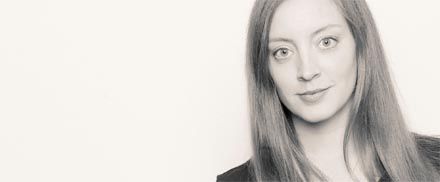
Claire Thomas has published short stories in various journals, including
Meanjin
and
Overland.
She has worked at a variety of jobs, including acting and bookselling, and is currently doing a PhD at the University of Melbourne. This month, she publishes her first novel,
Fugitive Blue.
She spoke to Jo Case for Readings.
What was the inspiration for this book?
The idea for Fugitive Blue came to me many years ago during an art history lecture about Renaissance artist materials when I first heard about lapis lazuli pigment and its immense mercantile value. I immediately thought – what if some of that got into inexperienced hands? What if a painting was created that was of substantial material value but without inherent artistic status? What if people through history still cherished that painting and maintained its longevity? It was that one little detail that triggered the whole story.
You have a background in art history. How did that influence you when writing the novel?
As a student of art history, I focused on twentieth-century art, and there is only a little bit of that in Fugitive Blue. In a way, it is a surprise to me that I have written a novel that features an artwork from fifteenth-century Venice. Still, that’s what I’ve done and I definitely grew to love that strange little panel painting. Fugitive Blue does, however, have a certain contemporary sensibility, which makes sense by the end of the novel.
In the writing of my book, I wanted to avoid traditional ideas about master painters and their masterpieces and instead highlight other ways of ascribing value to art. I wanted to look at the role of women in art, beyond that of the subservient muse. And perhaps, above all, I wanted to explore the material vulnerability of artworks that are often assumed to be objects that should last forever.
Fugitive Blue
In addition to the contemporary sections, the book has four historical settings – Bonegilla Migrant Reception Centre in the 1950s, Paris in the 1870s, Venice in the 1770s and early Renaissance Italy. In each case, I had some existing interest in the period and chose it as a stage in my story for that reason. But I did a heap of research for them all and found it endlessly fascinating, whether it was reading eighteenth-century Grand Tour diaries or accounts of life in the Paris Opera, or simply driving to Albury-Wodonga to see its trees.
The process was very simple: I’d immerse myself in an era for a few months, reading and absorbing as much detail as I possibly could. Eventually, when I felt like I was overflowing and desperate to process all the information, I’d write the related section. I wanted to know as much as possible about each period so I could write the stories fluidly, placing my characters into a clear world.
In the book, your main character falls in love with her work while restoring the striking ultramarine painting: becoming engrossed in it (to the detriment of other parts of her life). Did you become similarly engrossed in your novel while writing it?
Unfortunately, the writing of Fugitive Blue took too long for me to maintain that level of completely consuming affection! I loved it at times and thought it was a pathetic folly at other times. I wrote and re-wrote my novel over many years with a definite determination but never, I hope, to the detriment of my relationships. I am not a writer who buys into the whole neglect-or-take-advantage-of-your-loved-ones-for-the-benefit-of-your-own-terribly-important-fiction thing. I write as much as I can whenever I can, but there are other things I value just as much. I suppose what I had in common with my character was the (misguided or otherwise!) belief that my ‘project’ was worth pursuing and a certain discipline to see it through to the end.
What are the books and writers that influence you?
I love the writing of Mary Gaitskill, Joan Didion, Paula Fox, A.S. Byatt and Jeffrey Eugenides. In terms of the oldies, Henry James, George Eliot, Emily Bronte, Proust and Woolf have all meant a lot to me at various times in my life, and some of them still do. Recently, I’ve particularly enjoyed reading Nicola Barker’s Darkmans and re-reading Patrick White’s The Vivisector. And I am endlessly impressed with Helen Garner and Tim Winton – their longevity and the fact that they are very much themselves. I don’t even attempt to write like any of these authors but, as a reader, they’re some of the ones I love the most.


